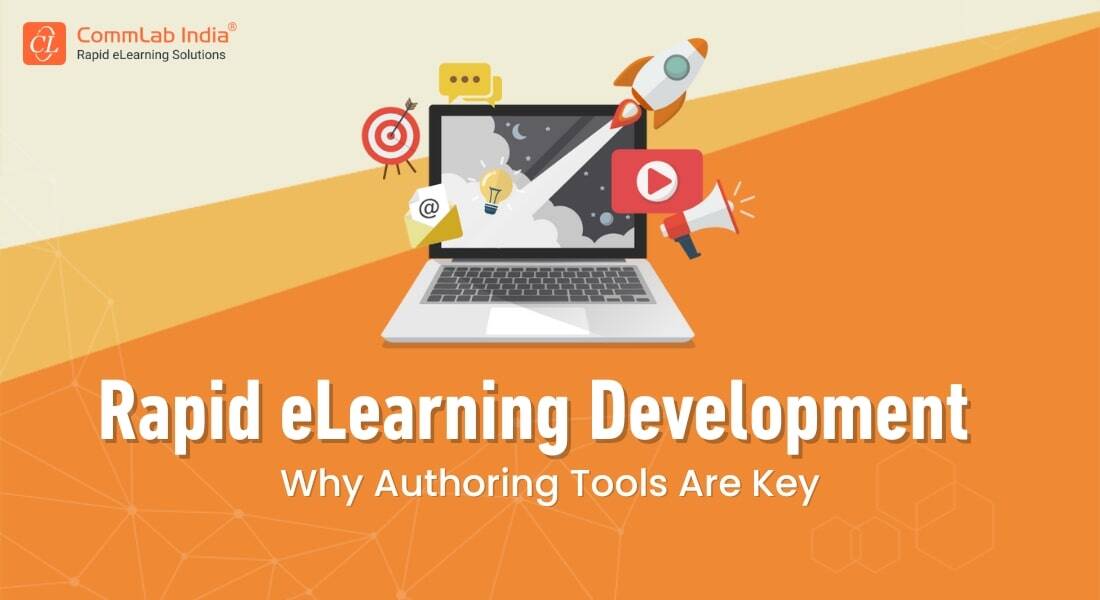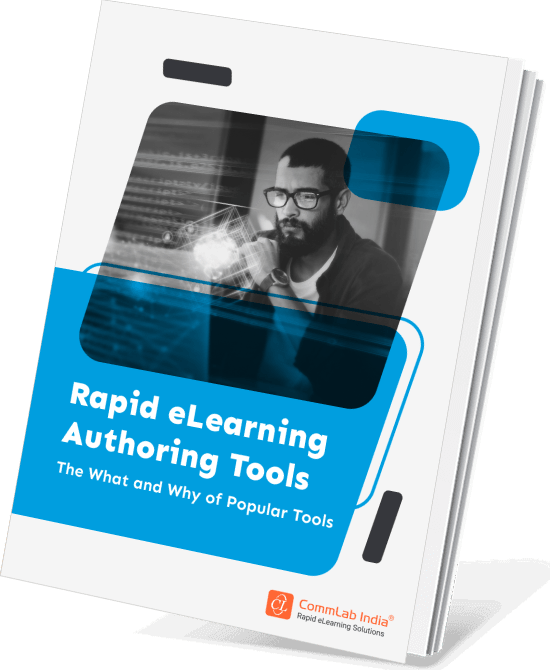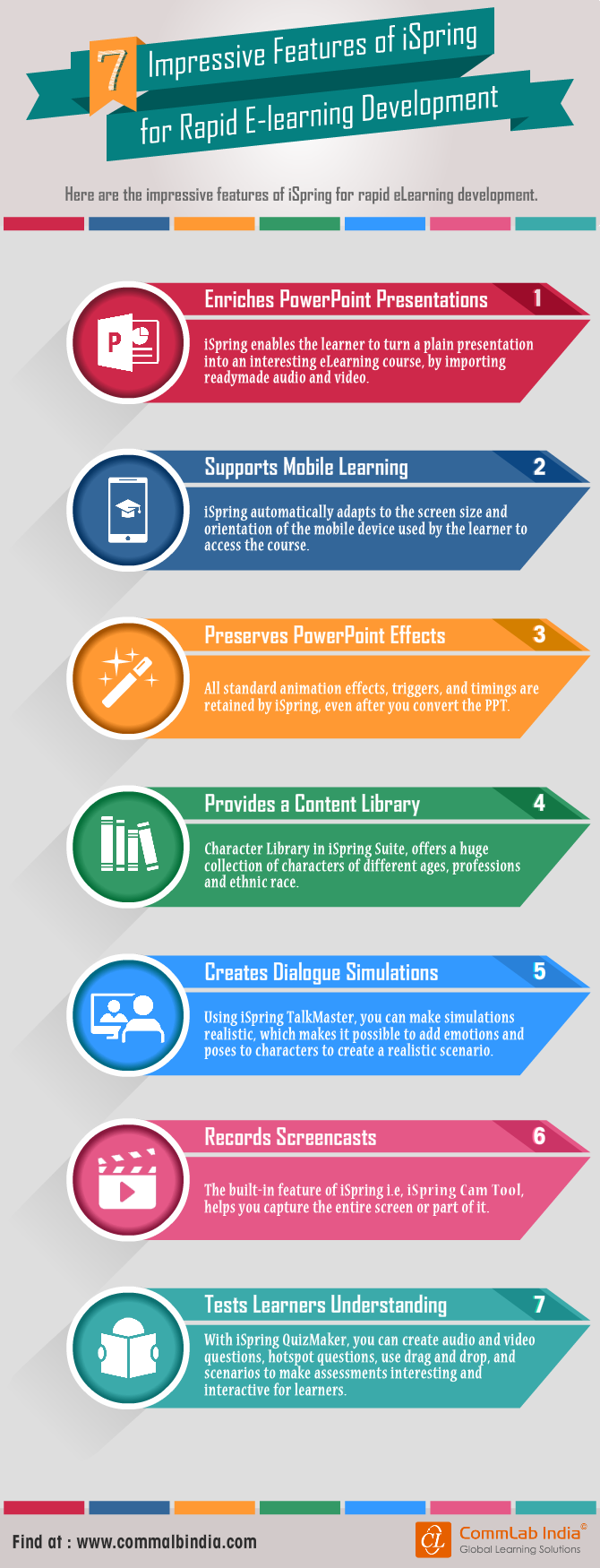How is Rapid eLearning Development Easier Than Ever with Authoring Tools?

When it comes to eLearning development, ‘time’ is one of the main factors to consider. The traditional development process of an eLearning course may take several months, with complexities at every step. But, with the advent of rapid Learning authoring tools, this developmental process has fastened up to address all your immediate training needs.
So, it’s time you bid adieu to traditional eLearning development woes as we enter the transformative era of eLearning tools loaded with efficiency and creativity!
→ Download eBook Now: Rapid eLearning Authoring Tools
Table of Content
- What is the History of Authoring Tools and eLearning Development?
- What are the Benefits of using Rapid eLearning Tools?
- What are the Different Types of Rapid Authoring Tools?
- What are the Key Features of Authoring Tools for Rapid eLearning Design & Development?
- What are the Best Rapid eLearning Authoring Tools?
- What are the Top FAQs about eLearning Authoring Tools?
What is the History of Authoring Tools and eLearning Development?
A rapid authoring tool is a user-friendly software that will revolutionize your eLearning development process, making it an engaging and interactive learning experience for learners.
Flash (due to extensive coding which is cumbersome and time-consuming) wasn’t able to keep up with changing training requirements for dynamic business needs. With the withdrawal of partnership by many technological giants – such as Microsoft, Google, Facebook – Adobe finally decided to pull the plug on Flash owing to its inadequacy in areas such as security, incompatibility with modern-day mobile devices, and so on in December 2020. But, for all its faults, Flash was once the pioneer eLearning authoring software but now, rapid authoring tools have taken over the market. These are faster, more efficient, and user-friendly.
It wouldn’t be wrong to say that authoring tools today hold the key to a successful rapid eLearning strategy. After all, it’s the in-built features of these authoring softwares that make the entire eLearning design and development process rapid.
What are the Benefits of using Rapid eLearning Tools?
The use of authoring tools has been growing over the past decade. Many companies now look forward to buying good eLearning authoring softwares or partnering with the right eLearning outsourcing vendors who can address the frequent training needs of organizations.
Here are the reasons for the rising popularity of eLearning authoring tools:
1. Rapid Development of eLearning Courses
You would be surprised to know that by using eLearning course authoring tools you can cut down at least 40% of time needed to develop the same course, traditionally. Developing an eLearning course has always been highly time-consuming, with a lot of complexities.
By using rapid authoring tools, you can now develop a 30-minute eLearning course in about 4 to 5 weeks, which otherwise would have taken several months. Thus, authoring tools have become an indispensable part of the eLearning industry.
2. Increased ROI on Training Programs
By using these tools, the number of man-hours required has come down substantially. As a result, the training costs also come down to as much as 50% less than the cost involved in developing the same course traditionally.
3. Mobile-Friendly Courses
eLearning authoring tools make it easy to create mobile-friendly courses, a crucial feature in today's mobile-first world. In the past, outdated technologies limited compatibility with mobile devices, but now these tools ensure seamless learning experiences across all screens.
4. Instructionally Sound Courses
Authoring tools encourage the participation of Subject Matter Experts (SMEs) and Instructional Designers (IDs), as there is no programming knowledge needed to design the course. There is ready availability of templates that are user-friendly and streamline the content to make it more systematic. Hence, it is easier for instructors and SMEs to execute what they visualize for the course, instead of getting it done through programmers, which could dilute the effectiveness of the content.

Rapid eLearning Authoring Tools
Explore the What and the Why of Popular Rapid eLearning Development Tools, and GenAI Tools
- Categories of eLearning Authoring Tools
- Considerations to Choose Your Next Authoring Tool
- Features of Popular Rapid Authoring Tools
- GenAI Tools to Create Content, Graphics, Audio, and Video
5. Course Updates are Easy
The courses need to be updated regularly to reflect changes in the content and meet the current needs of the organizations. eLearning authoring tools make updating courses very easy and convenient.
6. Good to Go in the First Go
Even professionals who are freshers with no prior designing experience find it very easy to design content on these tools. Right in the first handling of these tools, you can come up with creative unique content to impress target learners.
7. Make Use of Existing Content
Developing new images, presentations, graphics, text, etc. can be really time-consuming. How about modifying the existing ones to give you what you need exactly? That’s exactly what these authoring tools do, they modify the existing content to make it useful. And that’s how the entire process of eLearning development gets quicker.
Example: If a trainer has good existing PowerPoint slides, they can be used to create eLearning courses using rapid authoring tools.
8. Usability on Multiple Platforms
eLearning content built using these authoring tools can be accessed anytime and on any device of your choice like smartphones, tablets, computers, laptops, etc. These tools are also getting quickly updated to keep pace with new technological modifications on various devices.
What are the Different Types of Rapid Authoring Tools?
PowerPoint Add-ins
These are plug-ins added to Microsoft PowerPoint. When you add them, you get a tab on the ribbon containing the features available in the add-in.
The major benefit of such eLearning authoring tools is that they are very easy to use. The learning curve is very low, as anyone familiar with Microsoft PowerPoint can use it. These authoring tools are cheaper compared to the installed authoring tools. Articulate Studio and iSpring Suite are examples of PowerPoint add-ins.
Installed-based Authoring Tools
Unlike PowerPoint add-ins, installation-based authoring tools are standalone products and do not need any other software to work. You have to install these authoring tools on your computer to work with them. They come with a lot of built-in features, which can be tweaked to develop highly interactive courses.
However, these tools are expensive and have a longer learning curve compared to the PowerPoint add-ins and cloud-based authoring tools. Articulate Storyline is an example of an installed authoring tool.
Cloud-based Authoring Tools
These tools are typically offered as Software as a Service (SaaS) with monthly or annual subscriptions. Hosted online, they don’t require installation, allowing you to work from any internet-connected computer. Simply log in to the developer’s website with your credentials. These tools have a steeper learning curve than PowerPoint add-ins. However, they are easier to use than installation-based tools. Examples include Claro and Easygenerator.
Cloud-based tools are cost-effective since you pay as you use, rather than covering a full license fee upfront. You can work from anywhere on any device with internet access. However, this reliance on internet connectivity can be a drawback if you experience a poor or lost connection.
What are the Key Features of Authoring Tools for Rapid eLearning Design & Development?
Association for Talent Development (ATD) emphasizes the importance of choosing the right eLearning authoring tool based on factors such as functionality, ease of use, and scalability. They highlight that some tools are designed for rapid content development with minimal effort, while others offer advanced features for customization and scalability.
1. Media Libraries and Templates
Unlike classroom training that relies on books, manuals, and other material, eLearning relies more on visual elements such as images, animations, videos, and the like, to deliver information. Just imagine how tiring and expensive it would be if every time you need a new image for the course, you either have to create it from scratch or download it from commercial stock sites! And more often than not, you won’t find images or videos of your choice. That is why most eLearning tools have a built-in library of stock media assets such as buttons, clip art, locations, and characters. These media assets are royalty-free and come as part of the authoring tool suite. They cut down a lot on expenses and help in rapid eLearning development. They are highly customizable and can be adapted to accommodate specific needs and can also be reused multiple times.
2. Built-in Interactivities
Learning strategies have evolved over time and so has learning technology. New-age eLearning design involves highly interactive strategies like storytelling, branching scenarios, gamification, simulations, and augmented and virtual reality. However, using high-level eLearning interactivities doesn’t mean you have to spend a ton of training dollars or need months for course development. Authoring tools come with ready-to-use gamified templates that come in handy while designing courses and assessments. They also have screencast and screen recording features that allow ‘watch-try-do’ simulations. Authoring tools also have features that make it easy to develop VR-based eLearning. These courses boost learner engagement and improve knowledge retention by increasing learner participation, either by making them do or making them think.
3. Responsive Design
Mobile compatibility is no longer an option in online training – it has become a necessity to accommodate the needs of modern learners. They need access to training anytime and anywhere they want, on the device of their choice. As mobile devices become increasingly popular, courseware designers have been trying their best to make their eLearning courses mobile-compatible. After all, wasn’t mobile incompatibility one of the main strikes against Flash that led to its phasing out? Responsive eLearning design is a crucial authoring tool feature that allows the rapid development of mobile learning courses. Most modern rapid eLearning authoring tools publish mobile-friendly courses. However, the extent of responsiveness to screen size and orientation makes the difference.
4. eLearning Translation Features
Every language has its script, formatting, and style and the translated eLearning course needs to reflect it to effectively engage your global and diverse workforce. eLearning translations are one of the most difficult challenges in eLearning development. But thanks to rapid eLearning development with authoring tools, this has become a thing of the past!
5. Assessments Features
Assessments are an indispensable part of eLearning courses. They play an important role in evaluating learners’ understanding of the course content at regular intervals (formative assessments) and verifying if they have achieved the set performance-based learning objectives (summative assessments). Creating eLearning assessments using rapid eLearning authoring tools is incredibly easy because of the built-in templates for quizzes, Q&As, flashcards, and more. Authoring tools also allow randomizing the sequence of questions and giving feedback in creative ways. You can also make use of customizable game-based, scenario-based, and simulation-based templates for engaging assessments.
6. Latest Publishing Formats
eLearning technology standards are a set of universally accepted standards that determine the compatibility of eLearning courses across Learning Management Systems (LMSs). They are responsible for LMSs’ ability to track learners’ activities, set customized learning paths, and interoperability between LMSs. AICC is the earliest, SCORM is the most-widely used, and xAPI/Tin Can and cmi5 are the latest technology standards in the market. Most authoring tools publish SCORM-compliant eLearning courses but many tools publish courses to xAPI too. It is important to ensure that you choose SCORM authoring tools that are compatible with your LMS. Most organizations today still prefer SCORM courses, but if you want to implement advanced learning analytics for maximizing the impact of your online training, you should go for a tool that can publish xAPI courses.
7. Online Review Apps
In traditional eLearning development, a lot of time gets wasted in the endless review-feedback loop but with rapid eLearning, the whole review process is managed in a seamless and cohesive manner with minimum rework. This is possible because of the online review apps offered by authoring tools. These online review apps provide a common digital platform for all stakeholders and SMEs to share their opinions and feedback. In case you are dealing with multiple SMEs and stakeholders, they can review courses simultaneously. This means everyone can see everyone’s comments and conflicting feedback can be resolved cohesively. Using review tools streamlines your entire review-feedback loop and SMEs and stakeholders can access the courses to be reviewed anytime, anywhere.

Rapid eLearning Authoring Tools
Explore the What and the Why of Popular Rapid eLearning Development Tools, and GenAI Tools
- Categories of eLearning Authoring Tools
- Considerations to Choose Your Next Authoring Tool
- Features of Popular Rapid Authoring Tools
- GenAI Tools to Create Content, Graphics, Audio, and Video
What are the Best eLearning Authoring Tools?
eLearning Development with Rapid Authoring Tools – Deliver Knowledge Quickly and Effectively!
5 rapid authoring tools to have your eyes on:
1. Articulate Storyline
2. Articulate Rise
3. iSpring Suite
4. dominKnow | ONE
5. Elucidat
1. Articulate Storyline 360
Articulate Storyline 360 is a top choice among eLearning professionals for creating interactive and personalized courses quickly and efficiently. Known for its user-friendly interface and versatile features, it simplifies the process of designing engaging eLearning experiences. The tool supports seamless compatibility across operating systems, browsers, and devices of all screen sizes. Its rich asset library offers a variety of characters and templates, while features like 360-degree images provide immersive exploration opportunities through hotspots and markers. Additionally, motion path animations allow precise control over object movements, making it an ideal solution for crafting dynamic, high-quality eLearning content.
Want to create engaging and interactive eLearning courses? Let’s dive into how Articulate Storyline 360 can enhance eLearning courses.
2. Articulate Rise 360
Articulate Rise 360 is a web-based authoring tool within the Articulate 360 suite, designed for creating visually appealing and responsive eLearning courses directly in your browser, without the need for additional software. It features dynamic animation options like motion paths, entrance/exit effects, and transitions to enhance engagement. Rise 360 offers robust assessment capabilities, including randomized quizzes, custom feedback, and varied question types to boost learner retention. Committed to accessibility, it meets WCAG 2.1 Level AA standards with features like keyboard navigation, closed captions, and screen reader support in multiple languages. For seamless course delivery, it enables in-context feedback, and threaded discussions, and supports publishing in formats like SCORM, xAPI, cmi5, and AICC for easy LMS integration.
3. iSpring Suite
iSpring Suite is a powerful rapid eLearning authoring software designed to create engaging and accessible training content for any device, including mobiles, tablets, laptops, and desktops. It offers a range of features like QuizMaker for creating interactive quizzes, an Audio-Video Editor for seamless media editing, and a Content Library filled with templates, illustrations, and characters to enhance course design. The Character Builder lets you customize characters for various scenarios, while the AI Assistant streamlines content creation by generating course outlines, improving text, and crafting quizzes. With iSpring Suite, building professional eLearning courses becomes fast and efficient.
Discover what makes iSpring Suite a game-changer for creating eLearning content with these standout features!
4. dominKnow | ONE
dominKnow | ONE is a powerful course authoring software that combines a suite of features designed for efficient course creation. With tools like Claro, Flow, and Capture, it caters to diverse authoring needs, offering responsive design, robust assessment capabilities, and engaging content development. Being cloud-based, it allows teams to collaborate in real-time with ease, ensuring seamless accessibility and updates. The platform simplifies course translation with a straightforward three-step process, making it easy to manage multilingual content. Additionally, dominKnow | ONE supports industry accessibility standards with features like closed captions and transcripts, ensuring an inclusive learning experience.
Let’s dive into its features and see if it lives up to the hype!
5. Elucidat
Elucidat is a cloud eLearning authoring software designed for eLearning course creation with extensive customization options. It features adaptable templates for courses and assessments, seamless eLearning translations, and responsive course design. The tool supports multiple formats such as HTML5, video, SCORM, and xAPI, ensuring compatibility across major browsers. Elucidat also offers advanced assessment features, including randomized quizzes, personalized reports, and badges for learner recognition. Its variety of templates enables custom eLearning course creation for diverse learners, including microlearning modules, making it a powerful solution for professional eLearning content development.
What are the Top FAQs about eLearning Authoring Tools?
1. Which is the Most User-friendly Authoring Tool?
The user-friendliness of an authoring tool depends on factors like its learning curve, available pre-built assets, and features for custom eLearning courses. Ultimately, the key factor is how easy it is to use.
Here are the most user-friendly authoring tools, according to our developers:
- Articulate 360 (Storyline 360 and Rise 360)
- Adobe Captivate
2. What is the Perfect Tool to Convert Online Training Material into Interactive eBooks?
If you wish to quickly create eBooks or refurbish your existing online training material into eBooks, Adobe InDesign is the tool to go to. This tool allows the creation of different eBook formats – interactive PDFs and EPUB (electronic publication).
3. Which Authoring Tool to Choose for Developing a Simulation-based eLearning Course?
Adobe Captivate and Articulate Storyline are both excellent tools for creating simulation-based eLearning courses with features like high-resolution screen recording and easy editing options.
4. Which is the Ideal Tool for Creating Video-based Learning?
The ideal eLearning authoring tools for creating video-based learning are Articulate 360 and dominKnow. These platforms allow you to create responsive, mobile-friendly videos that automatically adjust to any screen size. They also enable you to develop interactive and microlearning videos, making them perfect for engaging learners effectively.
5. Which is the Most Flexible Tool to Create eLearning Assessments?
Storyline is the most flexible tool for creating and publishing interactive assessments. It offers multiple question types (graded and survey), lets you use images for creative assessments, and includes options to group or pool questions into banks. You can also import questions from text files, Excel, and other tools. It’s a versatile solution for building engaging, customizable eLearning assessments.
6. Which Tool has a Library to Store Audio and Video Files?
A library is available with all these eLearning authoring tools:
- Articulate Storyline
- Adobe Captivate
- dominKnow One
7. Which Tool Allows Publishing SCORM Compliant Courses?
All modern-day eLearning authoring tools have the feature to publish eLearning courses in the SCORM standard. You just need to select the option and publish it.
Wrapping up!
Rapid eLearning authoring tools are transforming corporate training—making it faster, smarter, and more engaging. Want to dive deeper into how these tools can reshape your eLearning game? Download our eBook now and explore everything you need to know about leveraging rapid authoring tools for success!









